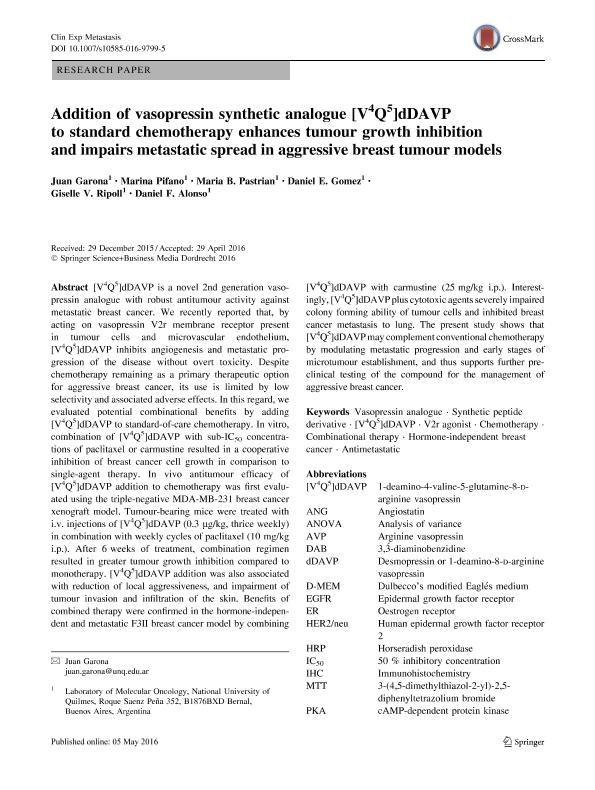Mostrar el registro sencillo del ítem
dc.contributor.author
Garona, Juan

dc.contributor.author
Pifano, Marina

dc.contributor.author
Pastrian, María Belén

dc.contributor.author
Gomez, Daniel Eduardo

dc.contributor.author
Ripoll, Giselle Vanina

dc.contributor.author
Alonso, Daniel Fernando

dc.date.available
2020-02-27T20:09:42Z
dc.date.issued
2016-08
dc.identifier.citation
Garona, Juan; Pifano, Marina; Pastrian, María Belén; Gomez, Daniel Eduardo; Ripoll, Giselle Vanina; et al.; Addition of vasopressin synthetic analogue [V4Q5]dDAVP to standard chemotherapy enhances tumour growth inhibition and impairs metastatic spread in aggressive breast tumour models; Springer; Clinical & Experimental Metastasis; 33; 6; 8-2016; 589-600
dc.identifier.issn
0262-0898
dc.identifier.uri
http://hdl.handle.net/11336/98527
dc.description.abstract
[V4Q5]dDAVP is a novel 2nd generation vasopressin analogue with robust antitumour activity against metastatic breast cancer. We recently reported that, by acting on vasopressin V2r membrane receptor present in tumour cells and microvascular endothelium, [V4Q5]dDAVP inhibits angiogenesis and metastatic progression of the disease without overt toxicity. Despite chemotherapy remaining as a primary therapeutic option for aggressive breast cancer, its use is limited by low selectivity and associated adverse effects. In this regard, we evaluated potential combinational benefits by adding [V4Q5]dDAVP to standard-of-care chemotherapy. In vitro, combination of [V4Q5]dDAVP with sub-IC50 concentrations of paclitaxel or carmustine resulted in a cooperative inhibition of breast cancer cell growth in comparison to single-agent therapy. In vivo antitumour efficacy of [V4Q5]dDAVP addition to chemotherapy was first evaluated using the triple-negative MDA-MB-231 breast cancer xenograft model. Tumour-bearing mice were treated with i.v. injections of [V4Q5]dDAVP (0.3 μg/kg, thrice weekly) in combination with weekly cycles of paclitaxel (10 mg/kg i.p.). After 6 weeks of treatment, combination regimen resulted in greater tumour growth inhibition compared to monotherapy. [V4Q5]dDAVP addition was also associated with reduction of local aggressiveness, and impairment of tumour invasion and infiltration of the skin. Benefits of combined therapy were confirmed in the hormone-independent and metastatic F3II breast cancer model by combining [V4Q5]dDAVP with carmustine (25 mg/kg i.p.). Interestingly, [V4Q5]dDAVP plus cytotoxic agents severely impaired colony forming ability of tumour cells and inhibited breast cancer metastasis to lung. The present study shows that [V4Q5]dDAVP may complement conventional chemotherapy by modulating metastatic progression and early stages of microtumour establishment, and thus supports further preclinical testing of the compound for the management of aggressive breast cancer.
dc.format
application/pdf
dc.language.iso
eng
dc.publisher
Springer

dc.rights
info:eu-repo/semantics/openAccess
dc.rights.uri
https://creativecommons.org/licenses/by-nc-sa/2.5/ar/
dc.subject
ANTIMETASTATIC
dc.subject
CHEMOTHERAPY
dc.subject
COMBINATIONAL THERAPY
dc.subject
HORMONE-INDEPENDENT BREAST CANCER
dc.subject
SYNTHETIC PEPTIDE DERIVATIVE
dc.subject
V2R AGONIST
dc.subject
VASOPRESSIN ANALOGUE
dc.subject
[V4Q5]DDAVP
dc.subject.classification
Otras Ciencias de la Salud

dc.subject.classification
Ciencias de la Salud

dc.subject.classification
CIENCIAS MÉDICAS Y DE LA SALUD

dc.title
Addition of vasopressin synthetic analogue [V4Q5]dDAVP to standard chemotherapy enhances tumour growth inhibition and impairs metastatic spread in aggressive breast tumour models
dc.type
info:eu-repo/semantics/article
dc.type
info:ar-repo/semantics/artículo
dc.type
info:eu-repo/semantics/publishedVersion
dc.date.updated
2020-02-26T14:56:29Z
dc.journal.volume
33
dc.journal.number
6
dc.journal.pagination
589-600
dc.journal.pais
Alemania

dc.journal.ciudad
Berlin
dc.description.fil
Fil: Garona, Juan. Universidad Nacional de Quilmes. Departamento de Ciencia y Tecnología. Laboratorio de Oncología Molecular; Argentina. Consejo Nacional de Investigaciones Científicas y Técnicas; Argentina
dc.description.fil
Fil: Pifano, Marina. Universidad Nacional de Quilmes. Departamento de Ciencia y Tecnología. Laboratorio de Oncología Molecular; Argentina. Consejo Nacional de Investigaciones Científicas y Técnicas; Argentina
dc.description.fil
Fil: Pastrian, María Belén. Universidad Nacional de Quilmes. Departamento de Ciencia y Tecnología. Laboratorio de Oncología Molecular; Argentina. Consejo Nacional de Investigaciones Científicas y Técnicas; Argentina
dc.description.fil
Fil: Gomez, Daniel Eduardo. Consejo Nacional de Investigaciones Científicas y Técnicas; Argentina. Universidad Nacional de Quilmes. Departamento de Ciencia y Tecnología. Laboratorio de Oncología Molecular; Argentina
dc.description.fil
Fil: Ripoll, Giselle Vanina. Universidad Nacional de Quilmes. Departamento de Ciencia y Tecnología. Laboratorio de Oncología Molecular; Argentina. Consejo Nacional de Investigaciones Científicas y Técnicas; Argentina
dc.description.fil
Fil: Alonso, Daniel Fernando. Consejo Nacional de Investigaciones Científicas y Técnicas; Argentina. Universidad Nacional de Quilmes. Departamento de Ciencia y Tecnología. Laboratorio de Oncología Molecular; Argentina
dc.journal.title
Clinical & Experimental Metastasis

dc.relation.alternativeid
info:eu-repo/semantics/altIdentifier/url/http://link.springer.com/article/10.1007%2Fs10585-016-9799-5
dc.relation.alternativeid
info:eu-repo/semantics/altIdentifier/doi/http://dx.doi.org/10.1007/s10585-016-9799-5
Archivos asociados
